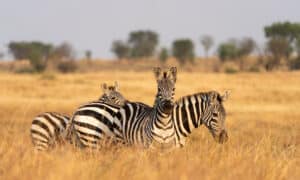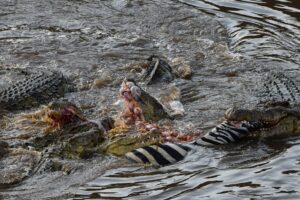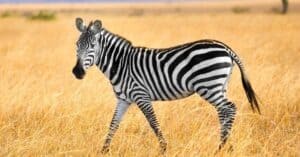Zebras are a type of African equid, characterized by their distinctive black and white striped coats. They have long legs and slender bodies, with short manes that stand upright on their necks. The stripes on each zebra are unique to the individual, much like human fingerprints.
Zebras come in three different species: plains zebras, mountain zebras, and Grevy’s zebras. Their natural habitats range from grasslands to mountainsides across various parts of Africa.
Despite their striking appearance, zebras are not just pretty faces. They also play an important role in the ecosystem as herbivores that graze on grasses and other vegetation. Additionally, they provide food for predators such as lions and hyenas.
A Group of Zebras
When it comes to the collective noun for a group of zebras, there are actually several options to choose from. The most commonly used term is “herd,” which is also used to describe groups of horses and other grazing animals. However, there are two more creative and poetic terms that have been coined specifically for zebras: “a dazzle” and “a zeal.” The word to describe a family of zebras comprising one male and several females (and their babies) is a harem of zebras.
The term “dazzle” may seem like an unusual choice at first glance, but it actually makes perfect sense when you consider the striking black-and-white stripes that make zebras so unique. When a group of these animals gathers together in the wild, their contrasting patterns can create an almost dizzying effect as they move en masse.
As for “zeal,” this word conveys both energy and enthusiasm – qualities that are often associated with these spirited creatures. Whether they’re galloping across the savanna or simply grazing contentedly together, there’s no denying that a group of zebras exudes a certain sense of vitality.
Of course, while all three terms can be used interchangeably depending on personal preference or context, one thing is clear: whether you call them a herd, dazzle, or zeal – there’s no mistaking the beauty and majesty of these magnificent animals!
Group Social Structure
Zebras live in two distinct types of social structures. Mountain and plains zebras form closed family groups, known as harems, which consist of one male, multiple females, and their offspring. These harems share overlapping home ranges and move around nomadically. When a stallion is replaced, the group remains stable. Plains zebras form large herds, with temporary subgroups forming within the herd, allowing individuals to interact with those outside of their family. The females in the harem gain protection and have more time to feed, and they have a linear dominance hierarchy, with the females who have been living in the group longest having the highest rank. As young zebras mature, they leave their natal groups; females are usually brought in by outside males to join their harems.
Grévy’s zebras living in more arid climates exhibit more fluid associations among adults. The most dominant males will stake out territory near a watering spot, which attracts females with young children and other mares who just want a drink. On the other hand, the less dominant males take up space away from the water source, and their territories typically contain more vegetation. A female zebra is able to move through multiple territories but will settle in one if she has a foal. By staying in one place, she can benefit from protection from other males and access to resources.
Young males who are not ready to form their own harems or territories typically form bachelor groups. Plains zebras typically have the oldest males as the most powerful, and their membership is usually solid. Bachelor groups tend to be on the edges of herds, and they usually follow behind or stay at the sides when the herd moves. In some cases, mountain zebra bachelor groups may include young females that have left their familial groups early, as well as aging males who used to have their own harems. When a Grévy’s zebra stallion has a territory, they may allow non-territorial bachelors to stay in their area, but if a mare in heat is around, the territorial stallion will keep other stallions away. Young males practice for their eventual harem roles by playing fights and doing greeting/challenge rituals, which take up most of their time.
Conflicts between males typically occur when competing for mates and involve kicking and biting. In Plains Zebras, a stallion will try to take over a recently grown mare, and her family stallion will defend against other males trying to snatch her away. As long as the harem stallion is fit, it is unlikely that he will be challenged. However, if he is unwell, then the new stallion will gradually take control in a peaceful manner.
Group Communication
Zebras are known for their striking black and white striped coats, but they also have a complex communication system that involves both vocalizations and visual cues. In terms of vocalizations, zebras can make a variety of sounds, including snorts, barks, brays, and whinnies. These sounds can convey different meanings depending on the context in which they are used. For example, a zebra might use a snort to signal alarm or danger, while a bray is often associated with aggression.
In addition to vocalizations, zebras also use visual communication through various facial expressions, head movements, ear movements, or tail postures. For instance, when threatened or alarmed by predators such as lions or hyenas – two common threats to these animals – zebras may flatten their ears against their heads as an indication of fear or stress. Alternatively, if they feel confident enough to confront the predator directly, they may stand tall with their ears erect and their tails held high.
Overall the communication system within groups of Zebras is highly sophisticated, allowing individuals within large herds to coordinate movement and respond effectively should any threat arise. This combination of sound signals along with visual cues ensures that members communicate effectively whilst keeping themselves safe from potential predators in the surrounding environment.
Group Greetings
One fascinating aspect of zebra behavior is how they greet each other in groups. Unlike other animals that use vocalizations or physical contact to communicate, zebras rely on a unique system of visual cues.
When two groups of zebras meet, they typically approach each other cautiously while keeping a safe distance apart. As they get closer, the members of each group will begin to raise and lower their heads while sniffing the air around them. This behavior allows them to collect information about the other group’s identity and status within their social hierarchy.
Once both groups have gathered enough information about each other, they may perform a series of greeting rituals that involve rubbing noses or nuzzling each other’s necks. They touch cheeks and sniff each other, then smell the other zebra from nose to tail in greeting. These interactions help establish trust between individuals and prevent conflicts from arising later on.
Group Migration
Zebras are known for their long-distance migrations from dry areas to wet areas in search of better food and water sources. These impressive animals can travel over 310 miles across the land, enduring harsh weather conditions and facing various challenges along the way.
Despite these difficulties, zebras have developed a remarkable memory for identifying the locations with the best forage and water sources. This allows them to make informed decisions about where to stop and rest during their migration journey.
During group migration, zebras often form large herds that can consist of hundreds or even thousands of individuals. This offers them protection against predators as they move through unfamiliar territories. The herds also allow weaker members, such as foals or injured individuals, to be supported by stronger ones.
Overall, zebra migration is a fascinating natural phenomenon that highlights the incredible adaptability and resilience of these majestic animals in their quest for survival.
Group Grooming
Group grooming is a common behavior among zebras and serves several important functions. First and foremost, it helps to reinforce social bonds within the herd, which is crucial for their survival in the wild. When zebras groom each other, they are also removing dirt and parasites from each other’s coats, which helps to keep them clean and healthy.
The process of group grooming typically begins with one zebra starting to nibble or scratch at another’s coat. This often triggers a chain reaction as more members of the herd join in on the grooming session. Zebras will use their teeth and lips to gently nip at each other’s fur while making soothing noises that help to calm everyone down.
Interestingly enough, zebras seem to have a particular preference for certain areas of their body during group grooming sessions. They tend to focus on hard-to-reach places like their backsides or underbelly, where parasites might be hiding.
Overall, group grooming is an important aspect of zebra social behavior that not only keeps them looking spiffy but also strengthens relationships within the herd.
Group Protection
Zebras are social animals and often gather in large groups. Within these groups, there is a sense of community and cooperation that allows them to protect their young from predators. When a threat approaches, the zebras will form a protective circle around the vulnerable members of the group, including the foals.
The formation of this protective circle is not random. It is carefully orchestrated by the dominant male or stallion of the group. The stallion uses his keen senses to detect potential danger and then leads his herd into position to defend against any threats.
Other members of the group also play important roles in protecting their young. Female zebras, for example, will sometimes move into positions on the outside edge of the circle where they can use their peripheral vision to spot any approaching predators.
In addition to forming circles around their young as a defense mechanism, zebras also use other tactics, such as running in zigzag patterns when being pursued by lions or other predators. This makes it more difficult for predators to catch them since they cannot anticipate which direction they will turn next.
Overall, through cooperation and coordination within a tightly knit social structure, zebras are able to successfully protect all of their young from harm while living in some of Africa’s most challenging ecosystems. They even babysit each other’s foals when the mother needs to leave to get water!
Group Meals
When it comes to group meals, zebras are known for their grazing habits. They typically graze together in large groups. These groups can range anywhere from a few individuals up to hundreds of zebras, depending on the location and availability of food sources.
Zebras are primarily grazers, meaning they feed on grasses and other vegetation found in their habitat. They have adapted well to this type of diet by developing teeth that allow them to efficiently grind down tough fibers in plants.
In terms of how much time they spend grazing, it varies based on factors such as seasonality and food availability. During dry seasons when food is scarce, zebras may spend up to 80% of their day searching for and consuming enough vegetation to meet their nutritional needs. However, during wetter months with more abundant plant growth, they may only need to graze for a few hours each day.
Overall, while there are certainly variations in how much and what types of vegetation zebras eat based on where they live and the time of year, one thing remains constant: these beautiful animals truly thrive when eating together in groups!
Group Mating and Reproduction
Plains and mountain zebras typically mate with one specific stallion, while Grévy’s zebras are more promiscuous. Females have a five to ten-day estrus cycle. When in the presence of a male, the female zebra will spread her legs and lift her tail, while the male will assess her reproductive state with a curled lip and bared teeth. Gestation usually lasts around a year, and after a few days to a month, the mare can go into estrus again.
Typically, one baby zebra is born and is up on four legs and ready to run within only one hour. To ensure safety, the mother zebra will prevent other zebras from approaching her baby until they have formed a bond. Once the baby is able to clearly recognize his mother by her voice, scent, and stripe pattern, then they can start bonding with the rest of the group. After a few weeks, the foal begins to graze but continues to nurse on its mother’s milk for 8-13 months. In dry environments, such as with Grévy’s zebras, the foal may begin drinking water sooner.
Conservation and Threats
Understanding the conservation status and threats facing each type of zebra is crucial in developing effective conservation strategies. Currently, three species of zebras are recognized: plains zebras, Grevy’s zebras, and mountain zebras. The plains zebra is listed as a species of Near Threatened by the International Union for Conservation of Nature (IUCN), while both Grevy’s and mountain zebras are classified as Endangered.
One major threat to all zebra populations is habitat loss due to human activities such as agriculture and urbanization. Additionally, poaching for their meat, skin, and medicinal purposes has led to population declines in some areas. In particular, Grevy’s zebras face significant threats from hunting for their beautiful skins as well as competition with livestock for resources.
Conservation efforts have been put in place to protect these endangered species from further decline. These include anti-poaching patrols and habitat restoration programs aimed at creating safe spaces for the animals to thrive. Education campaigns also play an important role in raising awareness about the importance of conserving these iconic African animals.
The photo featured at the top of this post is © Volodymyr Burdiak/Shutterstock.com
Thank you for reading! Have some feedback for us? Contact the AZ Animals editorial team.







